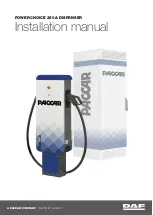
ELECTRIC VEHICLE - BATTERY CHARGER
General Information
15
charge algorithm that is appropriate to the specific battery type used in the vehicle. When the charger is connected,
there is a 2 to 5 second delay before charging begins. When the AC cord is connected, the charger performs a start-up
self-test (all three charger status indicators on the front of the charger flash ON at the same time).
The charger supplied with the electric vehicle resolves the most common problems associated with battery charging.
The charger utilizes sophisticated charge termination criterion to shut off automatically, preventing the possibility of
either undercharging or overcharging. The charger accomplishes this by monitoring battery voltage, charge current,
charge time and using strict dV/dt termination criterion.
Batteries should never be left in a discharged state, as this too affects the internal components and can reduce the
capacity of the battery. The batteries should be charged every day they are used. However, the batteries should
not be charged if they have not been used.
USB SERVICE PORT
The ERIC charger has a USB port for use by Club Car authorized technicians for data transfer, reconfiguration,
and updates. Keep the USB port cover in place when the port is not in use.
UL AND CSA LISTING
High-frequency charging system battery chargers have been listed by UL and by the Canadian Underwriters and
meet the criteria of the Canadian Standards Association.
CE COMPLIANCE
This battery charger is compliant with the EU EMC Directive 2004/108/EC.
PLUG AND RECEPTACLE
The charger cord, plug, and receptacle are wear items and should be inspected daily. Visually inspect for cracks,
loose connections, frayed wiring or bent pins; they must be immediately replaced when worn or damaged. Do not
attempt to straighten a bent pin. If charger plug or receptacle show signs of corrosion or the plug is difficult to insert
or remove, check for bent pins, then clean the receptacle contacts and plug terminals with a good electrical contact
cleaner or light coating of WD-40
®
brand spray lubricant. The plug should then be inserted and removed several times
to ensure ease of insertion, ease of removal, and good electrical contact.
DANGER
• To prevent fire, immediately replace battery charger DC cord plug and receptacle if the following
conditions exist:
– Plug pins have worn nickel plating and copper is exposed.
– Plug requires an inordinate amount of force to insert into receptacle, especially if accompanied
by a “grinding” feel.
WARNING
• If pins are bent, the plug must be replaced immediately. The plug is not serviceable. Do not attempt to
repair the plug or straighten bent pins.
• Disconnect the AC cord prior to lubricating the plug and receptacle.
NOTE:
If the warning tag has been damaged or removed from the DC cord, have it replaced immediately.
2020 Precedent,Villager 2 and 4 Maintenance and Service Manual
Page 15-3
Summary of Contents for DS Villager 4
Page 2: ......
Page 6: ......
Page 481: ...GASOLINE ENGINE HARNESS Wiring Diagrams Gasoline Engine Harness 26 ...
Page 482: ... Page intentionally left blank ...
Page 483: ...GASOLINE MAIN HARNESS Wiring Diagrams Gasoline Main Harness 26 ...
Page 484: ... Page intentionally left blank ...
Page 485: ...GASOLINE INSTRUMENT PANEL HARNESS Wiring Diagrams Gasoline Instrument Panel Harness 26 ...
Page 486: ... Page intentionally left blank ...
Page 488: ... Page intentionally left blank ...
Page 489: ...ELECTRIC MAIN HARNESS Wiring Diagrams Electric Main Harness 26 ...
Page 490: ... Page intentionally left blank ...
Page 492: ... Page intentionally left blank ...
Page 494: ... Page intentionally left blank ...
Page 495: ...ELECTRIC LIGHT HARNESS Wiring Diagrams Electric Light Harness 26 ...
Page 496: ... Page intentionally left blank ...
Page 497: ...ELECTRIC DC TO DC CONVERTER HARNESS Wiring Diagrams Electric DC to DC Converter Harness 26 ...
Page 498: ... Page intentionally left blank ...
Page 507: ...NOTES ...
Page 508: ...NOTES ...
Page 509: ......
Page 510: ......
















































